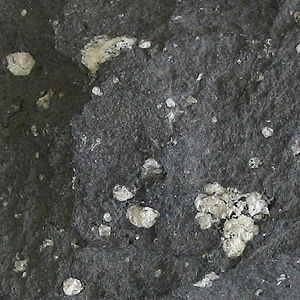Andesite

Andesite (IPA: /ˈandəsʌɪt/) is an igneous, volcanic rock, of intermediate composition, with aphanitic to porphyritic texture. The mineral assembly is typically dominated by plagioclase plus pyroxene and/or hornblende. Biotite, quartz, magnetite, sphene are common accessory minerals. Alkali feldspar may be present in minor amounts. The quartz-feldspar abundances in andesite and other volcanic rocks are illustrated in QAPF diagrams. Relative alkali and silica contents are illustrated in TAS diagrams.
Classification of andesites may be refined according to the most abundant phenocryst. Example: hornblende-phyric andesite, if hornblende is the principal accessory mineral.
Andesite can be considered as the extrusive equivalent to plutonic diorite. Andesites are characteristic of subduction tectonic environments in active oceanic margins, such as the western coast of South America. The name andesite is derived from the Andes mountain range.
Genesis of andesite
Andesite is formed at accretionary plate margins. Intermediate volcanic rocks are created via several processes:
- Dehydration melting of peridotite and fractional crystallization
- Melting of subducted slab containing sediments
- Magma mixing between felsic rhyolitic and mafic basaltic magmas in an intermediate reservoir prior to emplacement or eruption.
Via fractional crystallisation
Andesitic magma in island arc regions (i.e. active oceanic margins) comes from the interplay of the subducting plate and the mantle wedge, the part of the overriding plate above the subducted plate.
Water in the subducted oceanic crust 'boils off' from the slab by dehydration of hydrated minerals such as amphibole, zeolites, chlorite etc, which are formed in oceanic crust during hydrothermal circulation at the mid-ocean-ridge spreading centre. As these minerals are subjected to Barrovian Facies Sequence or Franciscan Facies Sequence metamorphism during subduction, they metamorphose to more stable, dehydrated forms, releasing water and volatile elements into the mantle wedge.
The slab itself, or the overlying mantle wedge, may melt. Melting subducted slab components have a sediment component from the subducted plate, which can be detected by increased lead and barium in the melts which are produced. The water and initial slab melts rise into the mantle wedge, prompting melting of the peridotite to produce a basaltic melt with a distinct subduction signature in its trace element composition (eg, shoshonite, adakite).
On its way to the surface, the melt stalls and cools, enabling the fractional crystallization of silica poor minerals, thus raising the silica content of the remaining melt and resulting in andesitic magma.
Via magma mixing
Basaltic magma may also mix with rhyolitic magma. This usually occurs in continental arc areas such as the Andes, where the high geothermal gradient above the subducted plate, and hydrothermal flows within the mantle wedge may create an underplate of softened, partially molten continental crust of intermediate or felsic composition. Basaltic magmas intruded into this anomalously hot zone will prompt partial melting of the crust, and may mix with these melts to produce intermediate compositions, typically andesite to trachyte in composition.
Alternatively, the basaltic melt may heat up the overlying arc, prompting partial melting, and may even assimilate sediments, previous volcanic rocks, etcetera, whilst undergoing fractional crystallisation. These rocks are subordinate due to the difficulty in assimilating sufficient cold material by magmas without cooling to a degree that they become immobile.
Ultimately, the resultant composition of andesite and intermediate magmas is the result of fractional crystallisation, assimilation, partial melting and contaminaton by the subducted slab. These may take considerable effort to resolve the individual components.
See also
- List of rocks
- Continental crust and the oceanic crust
- Metamorphism
- Origins of granite
- Fractional crystallization
- Andesite line
- Porphyry
External links
ReferencesISBN links support NWE through referral fees
- Origins of the Continental Crust
- Island arc magmatism
- Experimental and Theoretical Constraints on Peridotite Partial Melting in the Mantle Wedge
bg:Андезит de:Andesit et:Andesiit es:Andesita eu:Andesita fr:Andésite ko:안산암 id:Andesit it:Andesite he:אנדסיט lt:Andezitas hu:Andezit nl:Andesiet ja:安山岩 pl:Andezyt pt:Andesito ro:Andezit sk:Andezit fi:Andesiitti sv:Andesit zh:安山岩